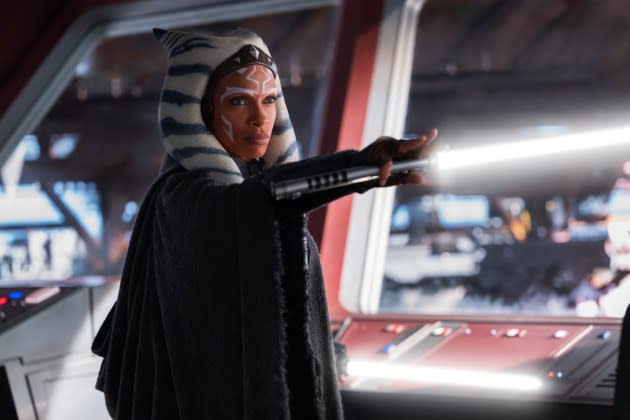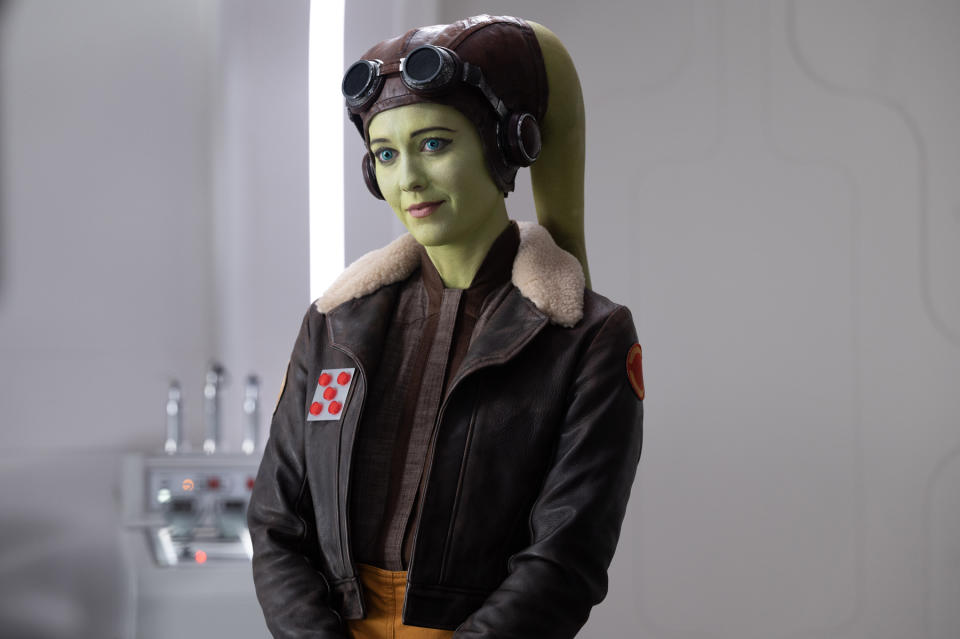‘Ahsoka’ Premiere: Non-‘Star Wars’ Superfans Will Be Lost in Space
- Oops!Something went wrong.Please try again later.
- Oops!Something went wrong.Please try again later.
- Oops!Something went wrong.Please try again later.
- Oops!Something went wrong.Please try again later.
- Oops!Something went wrong.Please try again later.

This post contains spoilers for the two-part series premiere of Ahsoka, now streaming on Disney+.
The Star Wars Disney+ shows run by Jon Favreau and/or Dave Filoni have had a very delicate relationship with Clone Wars and Rebels, the two animated series that Filoni ran in the 2000s and 2010s. The Mandalorian and The Book of Boba Fett have imported lots of characters who first appeared in animation, from Mandalorian aristocrat Bo-Katan Kryze to quick-drawing mercenary Cad Bane. But the central figures on both shows have either appeared exclusively or primarily in live-action. And Favreau and/or Filoni seemed to recognize that there is a large swath of Star Wars fandom that does not watch the cartoons, and thus needs some hand-holding whenever something like the Darksaber appears.
More from Rolling Stone
'Ahsoka' Is Here: How to Watch the New 'Star Wars' Series Online
Scott Pilgrim Is Back, Animated, Ready to Jam Some Bass and Battle Evil Exes
With Ahsoka, Filoni is flying solo. He wrote both of this week’s two episodes, and directed the first of them. This show is his baby, rather than something made in partnership with a filmmaker whose own experience is mainly in live-action. (Though Favreau did voice work on Clone Wars as Pre Vizsla, the ancestor of his Mandalorian character Paz Vizsla.) And if you take this show as his pure, uncompromising vision, then it suggests Favreau was the one being cautious about leaning too heavily on the animated material. Because Ahsoka could not more blatantly be a sequel to Rebels, for good and for ill.
Both episodes (the Filoni-directed “Master and Apprentice,” in particular) do a solid job of explaining who these people are for the uninitiated. This older, more guarded Ahsoka was already well-established in Rosario Dawson’s two previous appearances (once on Mandalorian, once on Boba Fett), so the focus here is much more on her once-and-future Padawan, Sabine Wren, played by Natasha Liu Bordizzo. We also get to know Hera Syndulla (Mary Elizabeth Winstead), former Rebellion pilot and now New Republic general, and a pair of droids in lightsaber expert Huyang (voiced by David Tennant) and neurotic astromech Chopper (voiced once again by Filoni).

I can only speak as someone who watched Rebels and thus could follow the plot, and appreciate small grace notes like Clancy Brown reprising his role as Ryder Azadi, governor of the planet Lothal, where much of the Rebels action was centered. But it felt like everything was more or less laid out clearly for the benefit of newcomers to this corner of the galaxy far, far away. And there’s also material that’s new to everyone, like the fact that, post-Rebels, Ahsoka unsuccessfully took Sabine under her wing as a would-be Jedi. Whatever issues Mandalorian and Boba Fett have had, Filoni is generally strong on basic storytelling craft, and that continues here.
But it’s one thing to be able to follow what’s happening and another thing to have an emotional investment in it. And it’s there where both “Master and Apprentice” and “Toil and Trouble” feel somewhat lacking. This reunion of three of the Rebels survivors(*) has an obvious plot function. As we’ve seen on Mandalorian, the Rebel victory in Return of the Jedi didn’t magically turn every Imperial loyalist into a devout believer in the New Republic. There are still bad people like Elia Kane, Werner Herzog(**), and, here, Morgan Elsbeth floating around, plus various rank-and-file Imperials like the group that causes trouble for Ahsoka and Hera at the shipyards on Corellia. But they have also reunited in the hopes of finding their old friend Ezra Bridger, who appeared to sacrifice himself in the Rebels finale to save Lothal and defeat the infamous Grand Admiral Thrawn.
(*) We know from a recent Mandalorian episode that another member of their old Rebel cell, Zeb Orrelios, is also serving in the New Republic. It would be more than a little surprising if this season concluded without him showing up to help out his pals.
(**) Yes, Herzog’s character is technically called “The Client,” but that’s too nondescript a name for such a memorably weird figure.
And it’s in both their relationships and their sense of loss with Ezra that Ahsoka feels most unapologetically like a Rebels follow-up — where the character work only matters if you go in already invested. Simply showing a holo of Ezra (played by Eman Esfandi), or having Sabine dwell on the mural she painted of him and the rest of the Ghost crew, only superficially captures what he meant to her, and to Hera, in the same way that the tension between Ahsoka and Sabine leans a lot on what we saw of Sabine’s growth over the course of four seasons. If you know Rebels, then it’s a huge deal that Ezra might be rescued from another galaxy; if you didn’t, he’s a MacGuffin.
But, again, Filoni is very strong at the basics of making TV in either two or three dimensions, and these episodes have a lot to enjoy regardless of your history with these characters. There’s thrilling action in both hours, starting with ex-Jedi Baylan (Ray Stevenson) and his apprentice Shin (Ivanna Sakhno) liberating Morgan from a New Republic ship, in a sequence designed to evoke Darth Vader’s assault on Prince Leia’s ship in the original Star Wars. Ahsoka’s use of dual lightsabers looks even cooler in live-action than when she deployed them in Clone Wars and Rebels, and Rosario Dawson’s cool charisma pops off the screen. The fight at the Corellian shipyard, with Hera and Chopper chasing a fleeing transport while Ahsoka battles an assassin droid and an Inquisitor(*), has all the clean choreography, editing, and photography you’d want from such a sequence, with director Steph Green leading an excellent crew for that. And there’s some material that works whether you remember the cartoons or not, like Tenant’s wry performance as Huyang, a Clone Wars character I had utterly forgotten.
(*) One issue that Filoni may need to deal with at some point: his previous shows have established that there were a lot of Force wielders who were active during the events of the original trilogy, whether good guys like Ahsoka, Ezra, and the late Kanan, or villains like the Inquisitors, yet none of them got involved in what the Skywalkers were up to — not even Ahsoka, who trained under and revered Anakin until he went to the Dark Side.
In premiering with two episodes rather than one, Disney+ gets most of the exposition and set-up out of the way quickly. There’s a clear conflict established here. It is a chase, with Morgan’s group trying to rescue Thrawn and use him to lead an Imperial revival, while Ahsoka and Sabine need to both stop Thrawn and save Ezra. That’s straightforward stuff, and the sort of material at which Filoni tends to excel. But Ahsoka also feels like a test case for that live-action vs. animation divide, and just how much Filoni and the others can lean on characters and story ideas from the cartoons and get all of fandom to care about them.
Best of Rolling Stone

